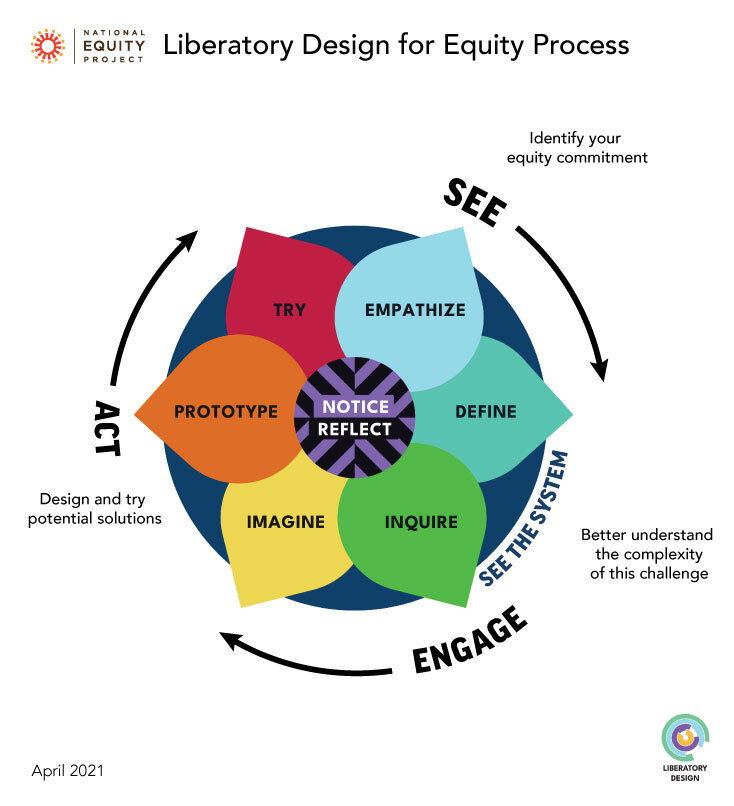Introduction to Liberatory Design
Why Liberatory Design?
We are all living in challenging times that our past experience and training has not sufficiently prepared us for. Too often, well intentioned equity efforts do not succeed—and even produce unintended consequences. This can lead to frustration, hopelessness and cynicism.
It’s important to consider why so many equity efforts stall or fail to achieve intended outcomes:
They do not employ a deep enough equity lens—for example, a diversity and inclusion focus as opposed to interrogating deeper causes produced by systemic oppression.
They take the form of traditional linear, hierarchical plans that focus on strategies, goals, timelines, metrics and accountability. These efforts don’t recognize the messiness and complexity of the challenge, so they often are ineffective and, sometimes, even backfire.
They are created in the context of dominant white culture, in traditional structures (e.g. committees, task forces), or in teams that don’t have an effective approach to the work. Common problems include:
group members unable to engage in authentic critical dialogue;
lack of trust, especially across role/power and identity difference, that undermines team efficacy;
the process doesn’t bring forward sufficiently creative thinking;
urgency leads to hasty, misguided decisions;
creative and potentially powerful solutions are not accepted by leadership.
What is Liberatory Design?
Liberatory Design is an approach to addressing equity challenges and change efforts in complex systems. It is grounded in an integrated part of NEP’s Leading for Equity Framework, which meshes human-centered design (aka design thinking) with complex systems theory, and deep equity practice. It is a process and practice to:
Create designs that help interrupt inequity and increase opportunity for those most impacted by oppression
Transform power by shifting the relationships between those who hold power to design and those impacted by these designs
Generate critical learning and increased agency for those involved in the design work
Liberatory Design is both a flexible process that can be used by teams and a set of equity leadership habits that can be practiced daily. It can be used in a variety of ways and by a variety of actors, including innovation efforts, strategic planning, community-driven design, and collaborative teams. At the core of Liberatory Design are a set of beliefs:
Racism and inequity have been designed into systems and thus can be redesigned;
Designing for equity requires the meaningful participation of those impacted by inequity; and
Equity-driven designs require equity and complexity informed processes.
Equity Leadership Habits
The drivers of Liberatory Design as practiced at the National Equity Project are the See-Engage-Act set of habits of our Leading for Equity Framework. These habits guide work at both the macro-level of a process over time and at the more micro level of a particular part of the design process.
SEE
See and understand the territory you’re navigating
ENGAGE
Engage others to make meaning of your current situation
ACT
Take action to address your equity challenge - and learn from that action
How does Liberatory Design work?
Unlike methodologies that have an elaborated set of steps and required tools, Liberatory Design is rooted in a simple set of resources: mindsets and modes.
Liberatory Design Mindsets
Mindsets are used to surface particular beliefs, values and stances to ground and focus design practice. The 12 mindsets are (find full descriptions in the Liberatory Design deck):
Build relational trust
Focus on human values
Work to transform power
Practice self-awareness
Seek liberatory collaboration
Exercise creative courage
Recognize oppression
Work with fear and discomfort
Take action to learn
Embrace complexity
Attend to healing
Share don’t sell
Liberatory Design Modes
Modes of the liberatory design cycle are practices that provide core structure and guidance for design processes. The following are brief descriptions of each mode (find full descriptions in the Liberatory Design deck):
See the System
Seeing the System enables us to identify potential equity challenges, what about the system is producing these, and what we need to learn more about as we engage in empathy work.
Imagine
Creating the time to brainstorm and imagine “what if?!” can unlock and unleash the creative courage that will lead to innovative approaches and solutions to equity challenges.
Empathize
Design opportunities to understand the experiences, emotions, and motivations of the person or community you are designing with. Empathize from a place of love, respect, and curiosity.
Prototype
Build rough versions of what you’re working on to test key ideas. Designing for equity requires creative experimentation.
Define
Develop a point of view about challenges and needs with the community. Together, look for patterns and insights in stories that reveal the deeper needs of the people closest to the challenge.
Try
Gather authentic feedback about prototypes to check your assumptions and intentions. Feedback is a gift used to improve whatever is being designed and ensure that the design is attuned to stated equity goals.
Inquire
Inquire when the way ahead is not clear. Inquire to help you better understand and define the challenge and to provide a clearer direction for your prototyping.
Notice & Reflect
At the center of Liberatory Design are the Notice and Reflect modes, which support groups and individuals to deepen their self-awareness and their situational awareness, as well as spur key pauses for reflecting and adapting throughout a process.
Liberatory Design (2021) is the result of a collaboration between Tania Anaissie, David Clifford, Susie Wise, and the National Equity Project [Victor Cary and Tom Malarkey]. Please visit www.liberatorydesign.com for more information on attributing this work.













